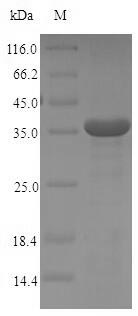The production of this Recombinant Human FCER1A protein required the insertion of a DNA fragment (FCER1A, 26-205aa) into a plasmid vector and the transferral of this vector into E.coli cells (the step of transformation). The cells were then cultured and induced to express the FCER1A protein. This recombinant protein was fused with N-terminal 6xHis-SUMO tag. Its purity is 90%+ determined by SDS-PAGE.
FCER1A (also known as FCE1A) is a gene providing an instruction of making a protein named high affinity immunoglobulin epsilon receptor subunit alpha (FCER1A) in human. FCER1A protein is also known as Fc-epsilon RI-alpha (FcERI) and IgE Fc receptor subunit alpha. This protein is a component of immunoglobulin epsilon receptor (IgE receptor), which is comprised of an alpha subunit, a beta subunit, and two gamma subunits. IgE receptor is the initiator of the allergic response by binding to the Fc region of immunoglobulins epsilon.






